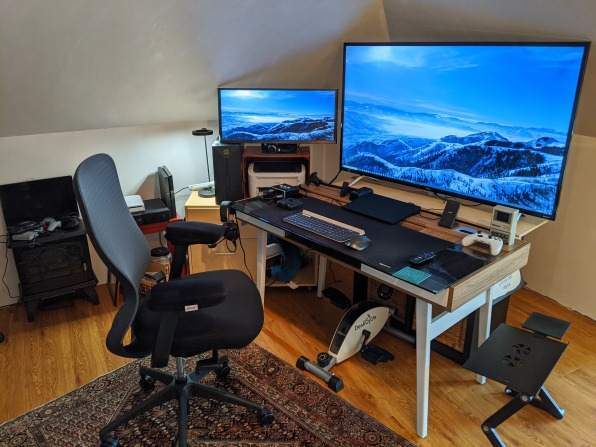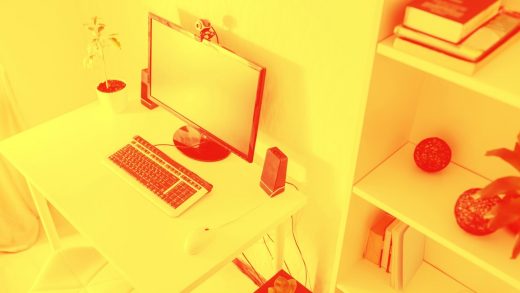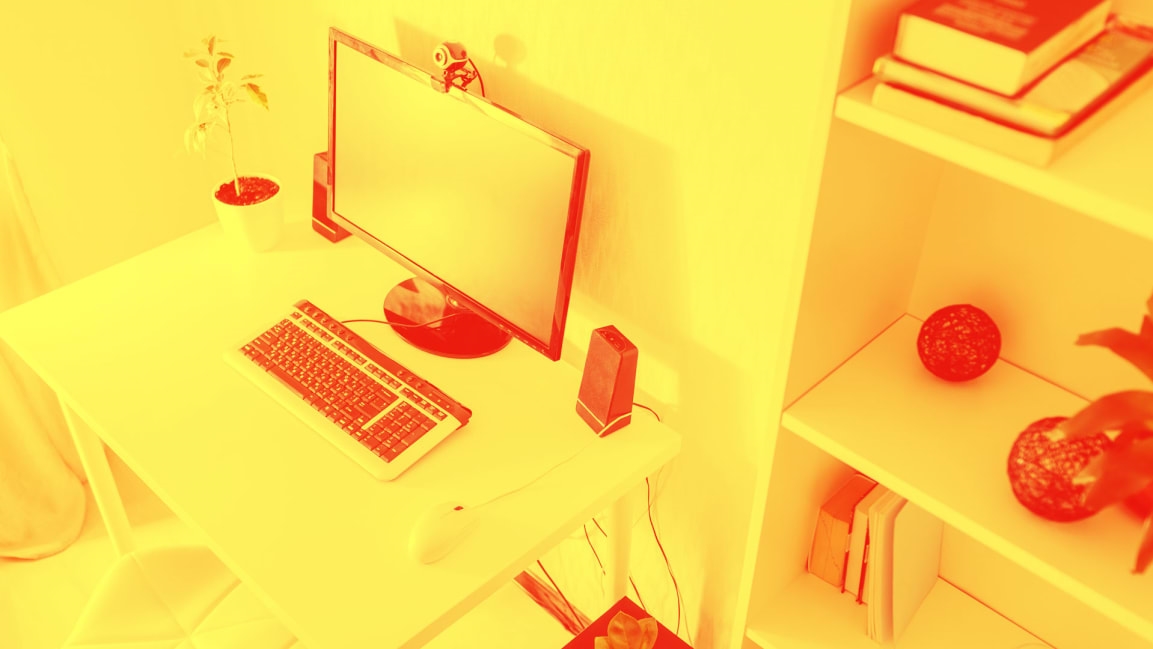I’ve worked from home for almost 20 years. These 6 tips make it awesome
So you’ve suddenly found yourself working from home—theoretically temporarily, perhaps not willingly, and all thanks to coronavirus. Well, I’m here to tell you that the WFH life is not so bad. In fact, it can be downright great.
Read just about any article offering tips for working from home, and you’ll likely come across the same general, gloomy advice. Hope you have a separate room for your office! Don’t stay in your PJs all day! Set boundaries between work time and personal time! Better find ways to increase human contact or you’ll surely go insane!
Enough already. I’ve spent about 80% of my career working remotely, and, in my unofficial opinion, working from home is the best. And you can and should work however you’re most comfortable because you’ll find that the more comfortable you are, the better you’ll produce. If you’re new to remote work or you’re having a hard time getting used to it, here are some things that make it great.
Figure out how you want to work
If you play your cards right, you don’t need to work like you’ve been used to working your whole life. It’s okay to keep working that way, but ask yourself: Do I want to stick to a structured block of time—say 8 a.m. to 5 p.m. each day? Or do I want to condense my work?
Removing your commute, an hour for lunch, and the idle chit-chat that would normally fill your day in the office, you might find that you can actually get your work done in five or six hours thanks to fewer distractions, shorter breaks, and a greater ability to focus. Make yourself available for meetings during regular hours, but then look for ways to work outside the confines of a nine-to-five if it means that you’ll produce better work. It benefits you, and it benefits your company.
If you’d like to stick to a more standard schedule, I’d suggest using the time that would normally eat up your morning commute for professional development instead. Take some online courses or tutorials that help you do your job more efficiently.
And then when it’s time to call it quits for the day, use the evening noncommute to wind down. Annoying as it might be, the conventional commute home actually helps you decompress from the workday and shift into nonwork mode. So read. Play some video games. Listen to a podcast. Tidy up. Stop working, but don’t leave your workspace and jump directly into domestic life right away.
Earning trust isn’t rocket science
The virus has forced many employers to be far more trusting than perhaps they generally are. And under normal circumstances, it’s one of the biggest stigmas of remote work: The fear that you’re just going to sit on the couch watching TV all day. If you’re working for someone who isn’t completely comfortable with overseeing off-site workers, see if you can structure your actual job so that it builds trust on its own. One easy way to do that is to deal in deliverables if you can. I make product videos for a living, so it’s pretty obvious whether or not I’m doing my job.
To be clear, my employer has built a dynamite worldwide, remote-friendly work environment. But just to be extra transparent, I have a task list (we use Asana) that’s viewable by anyone in my company and includes the current status for each project. So it’s very clear what I’m working on, how long it’s taking, and how much I’m getting done. Whatever your job entails, see if there are additional ways you can provide transparent tracking of your projects.
Customization is king
Perhaps this truly is a temporary situation for you, and you’ll be back in the office in no time. But for me, the single greatest part about working from home is being able to set my office up exactly how I want it. If your company will foot the bill for some new gear while you’re working remotely, great. And if you’re thinking of making a case for working from home more often, calculate how much you’ll save by not commuting and don’t be afraid to spend a bit of what you’ll pocket to create an inviting workspace. I’ve done it relatively inexpensively.

I use a 55-inch 4K smart TV as my main monitor, which would never, ever fly in a cube farm or open-office setup. But I highly recommend it. You can get a big, high-resolution TV for around $300 to $400, which lets you have multiple windows open at once without having to constantly switch back and forth between them. And since it’s a smart TV, I can use it for nonwork stuff as well, such as streaming video and playing video games. My workspace is half office, half lounge.
I’d also recommend an ultrawide monitor for around $200. I use both a big TV and an ultrawide monitor: the TV is for working on stuff, while the ultrawide is for email, Microsoft Teams, and general communication with coworkers. The extra horizontal workspace you get with an ultrawide monitor is great no matter what you do for a living and doesn’t cost all that much more than a regular skinny monitor.
Don’t forget about the little things too. Buy the best mouse, keyboard, and headset you can get: They’re your work weapons. Pay for the strongest internet connection you can afford: Don’t ruin a video chat because your kids are streaming Netflix.
And for the love of all things pure and good in this world, do not—under any circumstances— skimp on your office chair. You don’t have to spend a fortune: Staples sells the popular Ayalon model for around $200, which is generally considered a poor man’s Herman Miller. I have it and like it. Staples also carries a line of Tempur-Pedic chairs for between $200 and $300, which I’ve used and found pretty good.
“Blurred work-life lines” are bogus
Another common fear about working from home: You can never really shut it off, right? If someone sends you an email at 8 p.m., you’ll feel compelled to head to your desk to respond.
This problem—if you want to call it a problem—is more a reflection on the environment fostered by your company than anything else. Look around the office and watch how many people stuff their laptops into their bags so they can do work after hours at home. It’s the 21st century, and we can work from anywhere. If you feel like acting upon an email late at night, then go ahead. If not, let it wait until morning, assuming there’s no expectation that you respond right away.
Conversely, sometimes it’s awesome to have a proper work setup mere steps from the couch so that you’re able to turn things around quickly during off-hours. Maybe, like me, you’re more creative at 10 p.m. than 10 a.m., so it’s nice to be able to do your best work at odd times.
Multitasking is real, and it’s fabulous
One of the most noticeable side effects of working from home is that you’ll feel less like you’re trying to cram a million things into each day. So take this time, however temporary, to get things done that you wouldn’t be able to get done while in the office. Don’t not work, of course: Just look for ways to maximize the benefits of having most of your belongings in your general vicinity at all times.
A DeskCycle recumbent bike sits under my desk. It’s perfect for burning some calories while I watch an hour-long webinar. Got 10 minutes between meetings? Instead of mindlessly surfing the web until your next call, go throw a load of laundry in or do the dishes real quick.
One of the best things about not being in an office all day is that if you’ve set yourself up properly at home, idle time fundamentally disappears. You’ll also feel less like you “need” a break every so often, which leads to more focused work.
There are no more “Sunday Sickies”
During one era of my career, when I commuted to an office, I was sitting around with a group of friends who also commuted. It was late on a beautiful Sunday afternoon when one of them asked, “Do you guys ever get a weird feeling in your stomach on Sunday night? Like, you know you have to go back to work tomorrow, but you don’t want to go into the office?” We all agreed that, yes, we had this feeling. As a result, the term “Sunday Sickies” was born.
Perhaps more importantly, I was smack-dab in the middle of negotiations with my company to shift fully to remote work. Once it approved, the Sunday Sickies went away completely. And it wasn’t that I didn’t like my job. I just hated commuting, and I never felt comfortable in the office once I got there. Almost overnight, I felt more energized, I did better work, and I was generally much, much happier.
I now live in a little beach town north of Boston that’s home to a sizable population of remote workers. I make sure to ask each of them as I meet them if they get the Sunday Sickies. I’m happy to report that not a single respondent has reported such a sensation.
These can be trying times if you’re not used to working from home. But look to embrace all the good things about remote work and you just might find that you enjoy it more than you thought you would.
(11)



